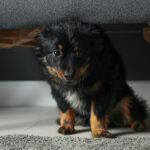Do you ever find your puppy exhibiting anxious or excited behavior and don’t know what to do? We’ve all been there—our puppies wriggle around, bark incessantly, and even get too mouthy. But why does this happen in the first place? Understanding how our furry friends feel is vital in calming anxious puppies down when they become nervous or too pumped up. In this blog post, we’ll delve into the causes of anxiety and excitability in puppies—and show you practical ways how to soothe an overly amped-up pup best!
What are some tips for introducing a dog to new people or environments?
Socialization is vital to a puppy, but it must be done in a controlled environment that doesn’t overwhelm the dog. Rather than taking a new puppy to a dog park and forcing him to interact with many new dogs and people, introduce your puppy to one new dog or person. Allow the dog to meet or approach the new dog or person at his own pace. This allows the dog to control the situation and gain confidence. When meeting a new person, feed the dog treats so that he learns good stuff happens when around new people.
How can I keep my puppy from getting overly excited when people visit the house?
The dog can gain confidence if observing the visitors from a safe space, such as a crate or kennel. Allow him to observe for several minutes and then approach the new person at his own pace. If you act calm and confident and don’t get overly excited when visitors come, the puppy may follow your lead.
What helps develop a calm, confident puppy?
Dogs like routines and structure and like it when they know what is expected of them. Some ways you can calm an anxious puppy by giving your dog structure are:
- Feed him in the same place and at the same time each day.
- Provide your dog with a safe, quiet place, such as a crate or kennel, where he can sleep.
- Give your puppy exercise and playtime. Puppies generally do better with several short play or exercise sessions throughout the day rather than one long session.
- Offer your puppy safe, appropriate chews and toys. Most dogs enjoy puzzle toys.
- Use positive reinforcement to teach your puppy basic obedience work, such as sit and lie down.
What steps should I take to prevent separation anxiety in a puppy?
Preventing separation anxiety in puppies is essential for their psychological well-being. As social beings, dogs are prone to anxiety when separated from their owners. To avoid this, starting slowly and gradually increasing the time the puppy is left alone is essential. Experts recommend starting with short periods of separation, especially when the puppy is tired or just finished eating, as this can decrease their level of anxiety. It is also crucial to provide a safe and comfortable environment for the puppy, with toys and treats to keep them entertained while their owner is away.
Additionally, a consistent routine can be beneficial, as it helps the puppy develop a sense of security and predictability. Another tip is to provide positive reinforcement when the puppy displays calm behavior during periods of separation. This encourages good behavior and reinforces that being alone is not scary or overwhelming. Ultimately, preventing separation anxiety in puppies requires patience, consistency, and a lot of love and attention from their owners.
Where can I get more information on calming my anxious puppy?
If you are a pet owner who wants to raise a calm and confident dog, here are some great books to consider.
- “Don’t Shoot the Dog” by Karen Pryor – This classic book on dog training is a must-read for any pet owner who wants to learn the basics of positive reinforcement. Pryor explains how to use rewards to encourage desirable behaviors in your dog and how to avoid punishing your dog for unwanted behaviors.
- “The Puppy Primer” by Patricia McConnell and Brenda Scidmore – Focusing specifically on puppy training, this book provides a comprehensive guide to raising a confident and well-behaved puppy. It covers everything from basic commands to socialization and emphasizes the importance of positive reinforcement to encourage good behavior.
- “The Power of Positive Dog Training” by Pat Miller – This book provides a step-by-step guide to using positive reinforcement to train your dog. Miller explains how to create a training plan, use rewards effectively, and deal with typical behavior issues.
- “Training the Best Dog Ever” by Larry Kay and Dawn Sylvia-Stasiewicz – This book takes a holistic approach to dog training, emphasizing the importance of building a strong bond with your dog through positive reinforcement. It provides a comprehensive training plan that covers everything from basic obedience to advanced tricks.
- “The Culture Clash” by Jean Donaldson – While not strictly focused on positive reinforcement, this book takes a thought-provoking look at how humans and dogs interact. Donaldson argues that many problems between humans and dogs are due to misunderstandings and miscommunication, and she provides practical advice on how to bridge the gap.
Contact us to schedule an appointment
Raising a calm, confident puppy takes time and patience. It always helps to ensure you are taking care of the dog’s physical, emotional, and social needs. If you have questions about calming your anxious puppy, you can ask us when you bring your puppy in for his wellness appointments and vaccinations. Call us today to schedule an appointment.






